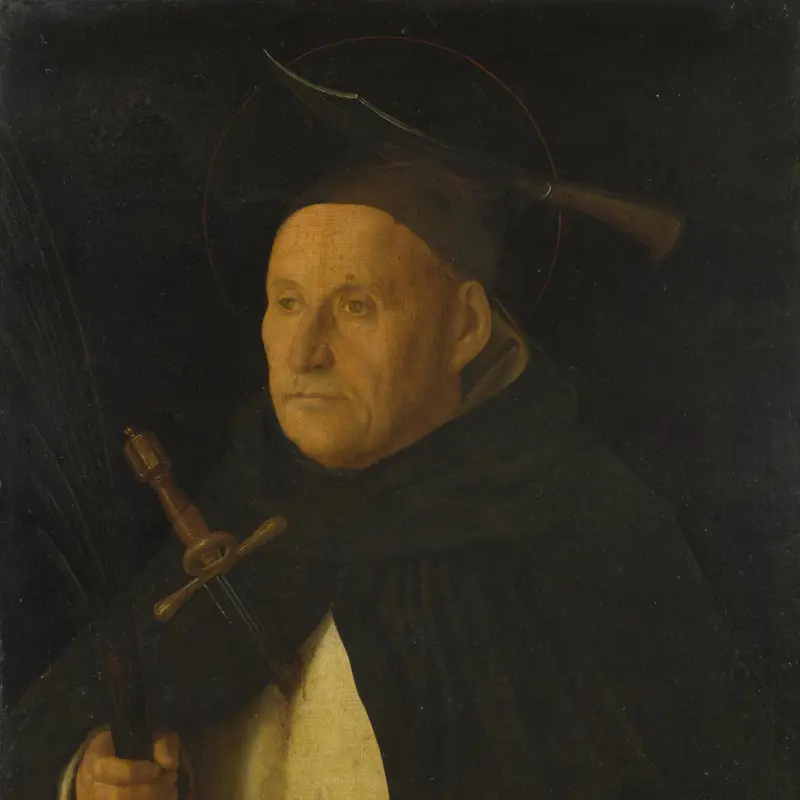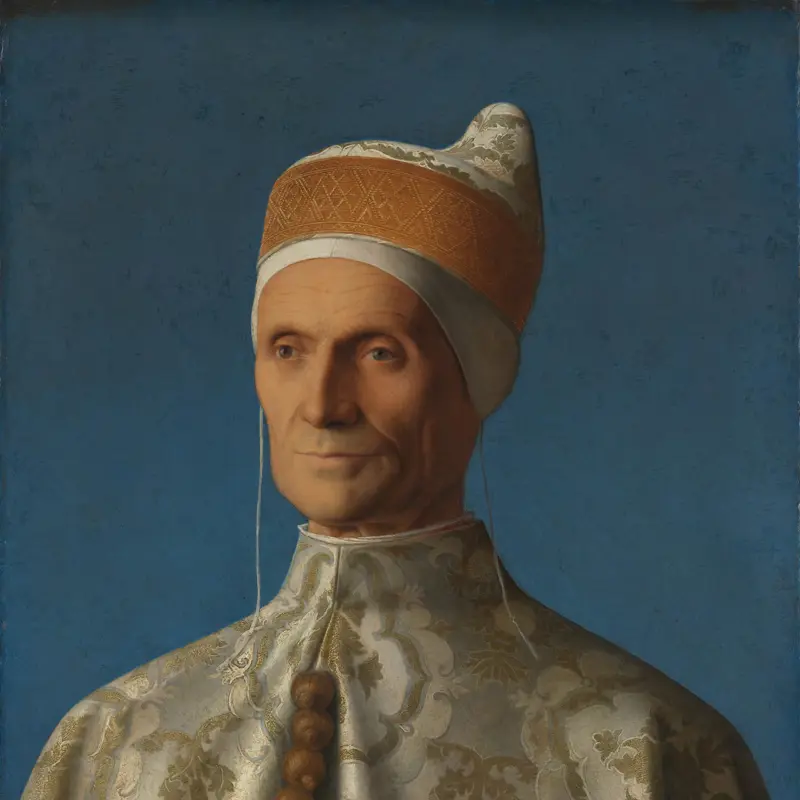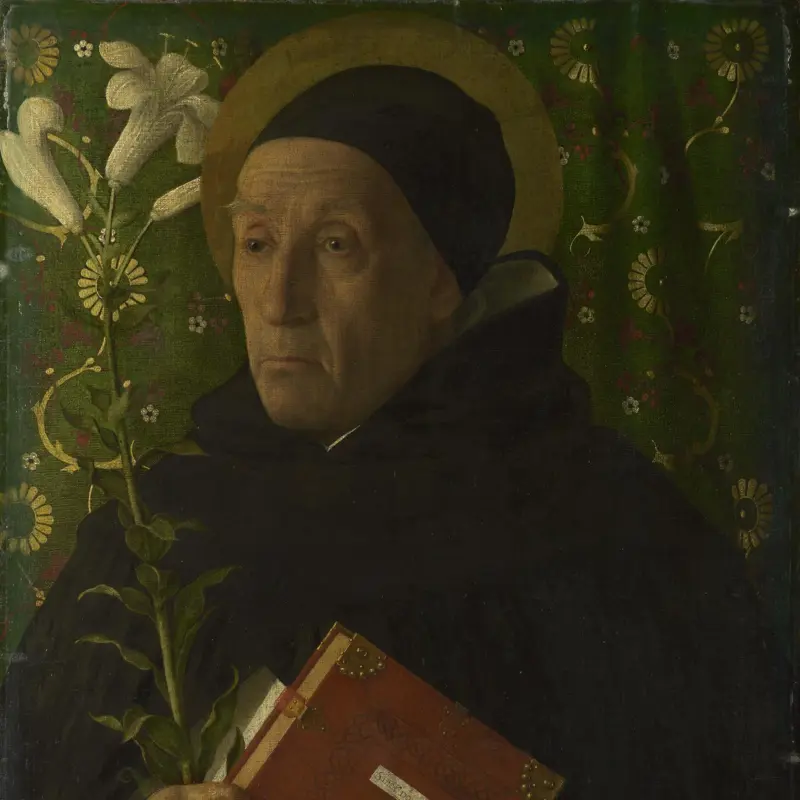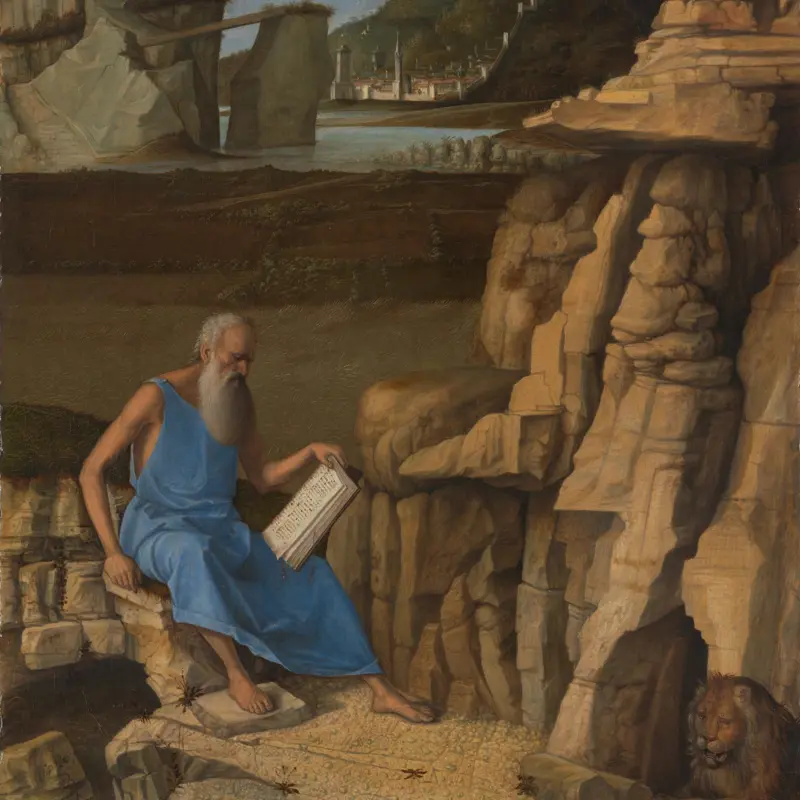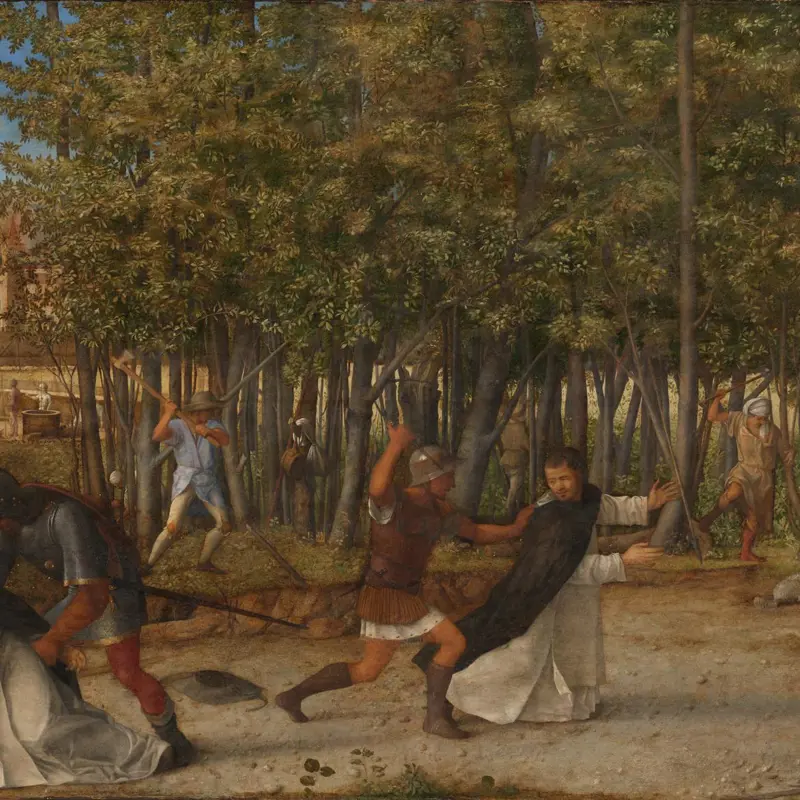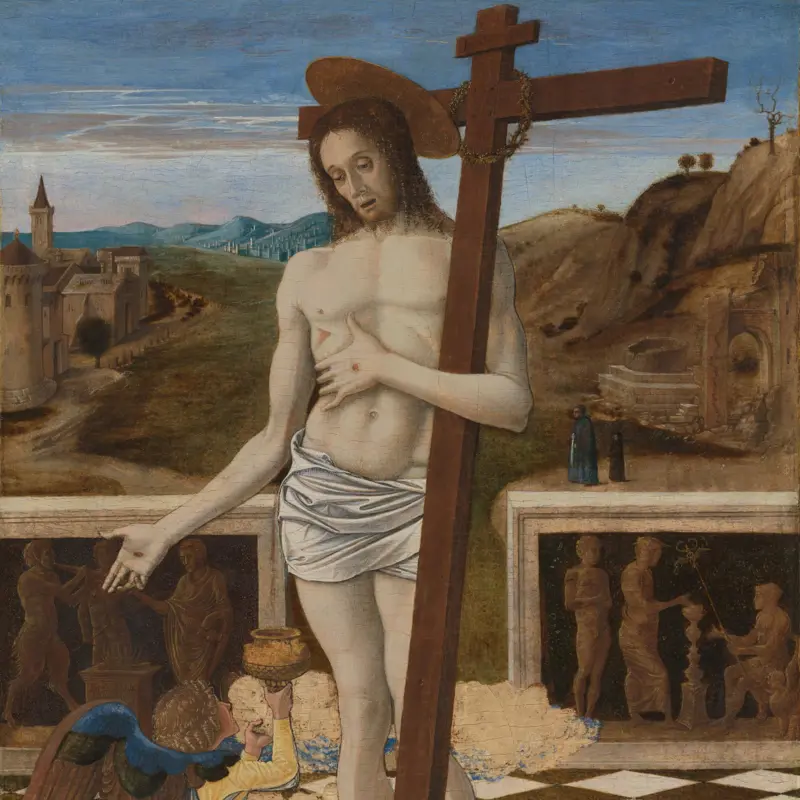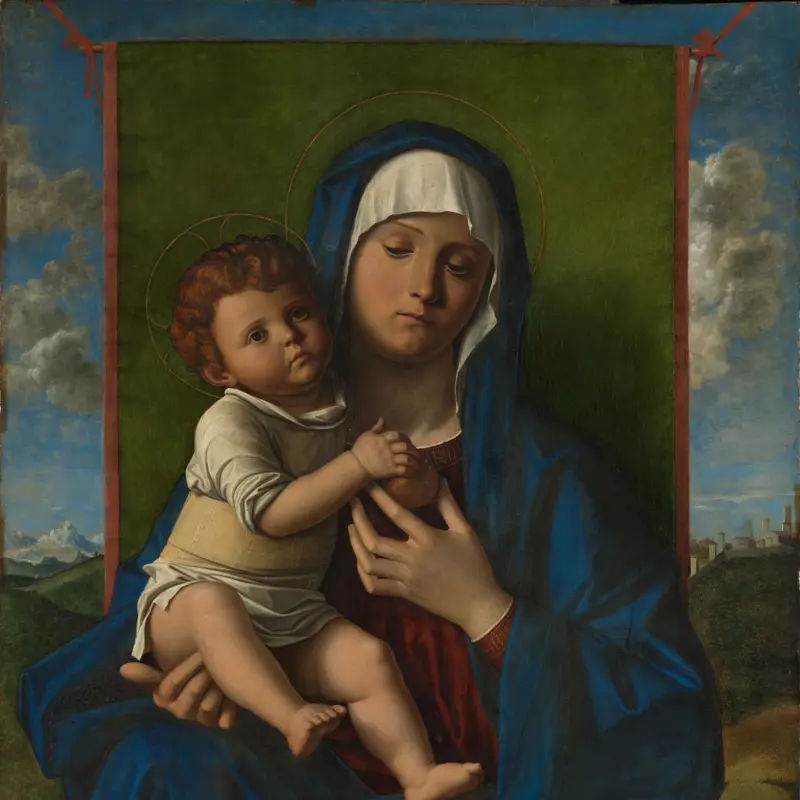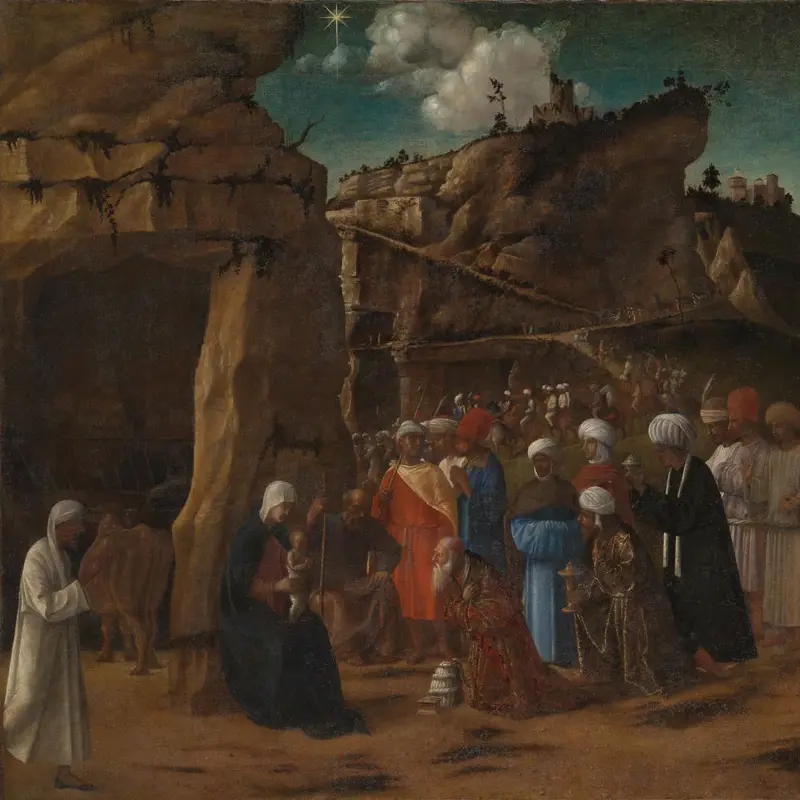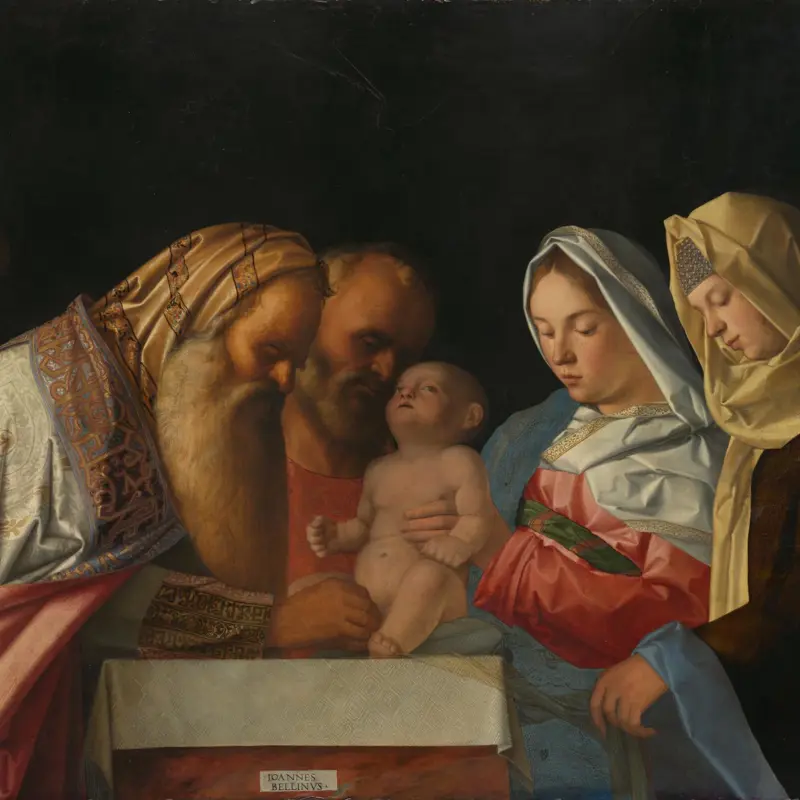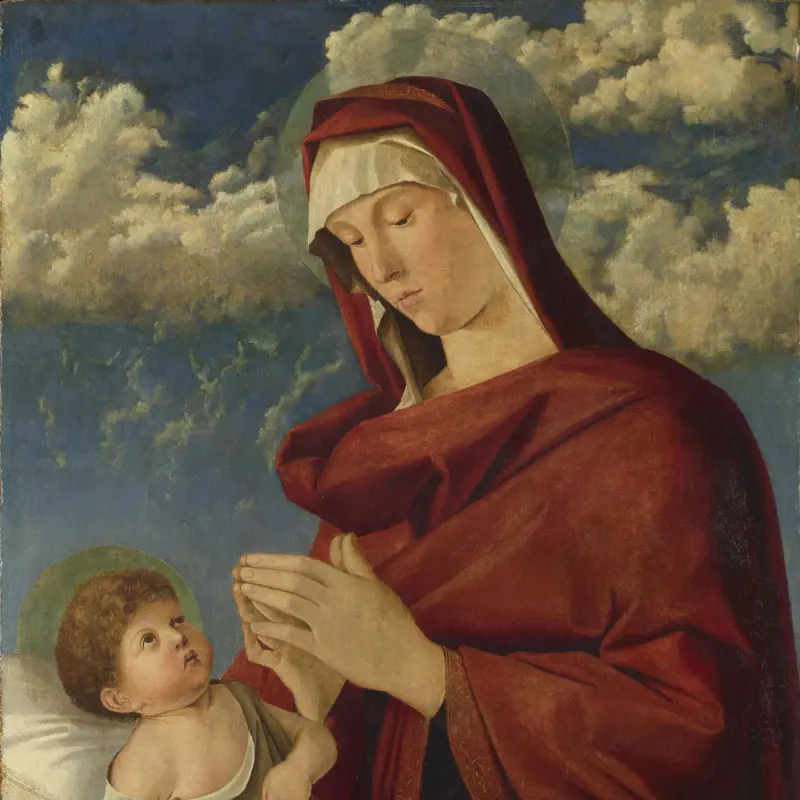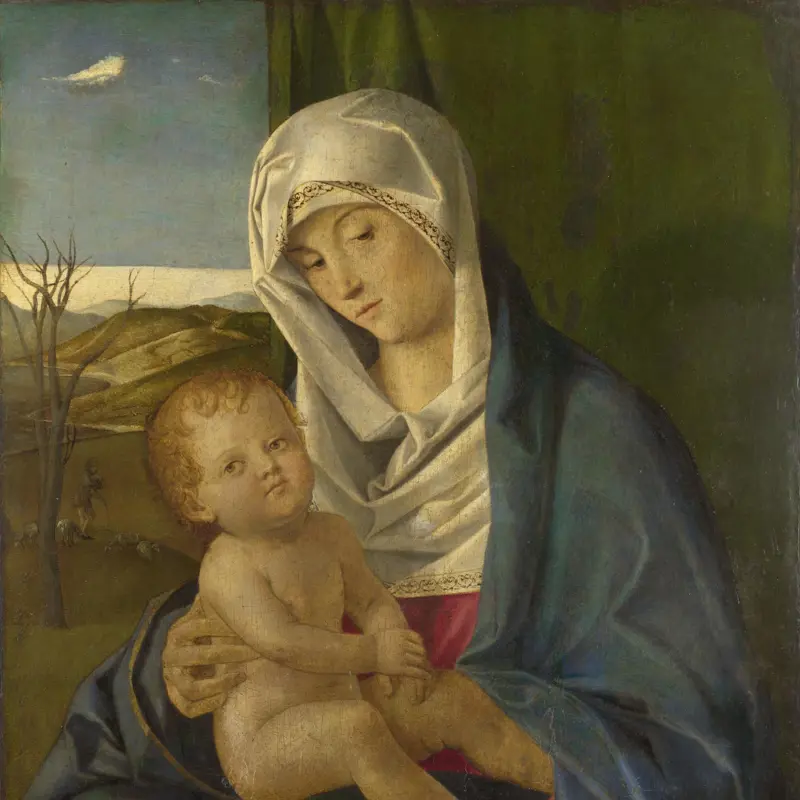Giovanni Bellini, 'The Agony in the Garden', about 1458-60
About the work
Overview
Christ’s disciple Judas – visible just beyond the river, leading a group of soldiers to Christ – has betrayed him. Aware of his imminent arrest and death, Christ prays; a cherub appears and presents him with a chalice. The chalice refers to the words of his prayer: ‘My Father, if it be possible, let this cup pass from me; nevertheless, not as I will, but as thou wilt’ (Matthew 26: 39).
Here Bellini experiments with the style of his brother-in-law, Andrea Mantegna: the rock forms in the foreground on the left have straight edges and look, like Mantegna’s, as though they have been carved with a chisel. The draperies, too, resemble Mantegna’s in their crisp sharp folds.
Christ’s pink tunic blends with the peach light of the dawn sky, which highlights the undersides of the plump clouds. Bellini would continue to develop his extraordinary sensitivity for the changing effects of light on landscapes throughout his career.
Key facts
Details
- Full title
- The Agony in the Garden
- Artist
- Giovanni Bellini
- Artist dates
- about 1435 - 1516
- Date made
- about 1458-60
- Medium and support
- egg tempera on wood
- Dimensions
- 80.4 × 127 cm
- Acquisition credit
- Bought, 1863
- Inventory number
- NG726
- Location
- Room 63
- Collection
- Main Collection
- Previous owners
Provenance
Additional information
Text extracted from the ‘Provenance’ section of the catalogue entry in Martin Davies, ‘National Gallery Catalogues: The Earlier Italian Schools’, London 1986; for further information, see the full catalogue entry.
Exhibition history
-
2016Painters' Paintings: From Freud to Van DyckThe National Gallery (London)23 June 2016 - 4 September 2016
-
2018Mantegna and BelliniThe National Gallery (London)1 October 2018 - 27 January 2019
-
2018Mantegna and Bellini: Masters of the RenaissanceGemäldegalerie (Berlin)1 March 2019 - 30 June 2019
Bibliography
-
1795Christie, Manson & Woods, A Catalogue of the Capital, Genuine and Valuable Collection of Pictures, late the Property of… Sir Joshua Reynolds, London, 11 March 1795 - 14 March 1795
-
1812J. Storer, Description of Fonthill Abbey, Wiltshire, London 1812
-
1822J. Rutter, A Description of Fonthill Abbey and Demesne, in the County of Wilts: Including A List of Its Paintings, Cabinets, and Other Curiosies, 2nd edn, Shaftesbury 1822
-
1822J. Christie, Magnificent Effects at Fonthill Abbey, London, 8 October 1822 - 17 October 1822
-
1823Phillips, The Valuable Library of Books at Fonthill Abbey, London, 9 September 1823 - 31 October 1823
-
1847Christie & Manson, Catalogue of the Valuable Collection of English Historical Portraits in Oil and Miniature … Also the Collection of Pictures … of Edward Harman, Esq., London, 27 May 1847 - 29 May 1847
-
1854G.F. Waagen, Treasures of Art in Great Britain: Being and Account of the Chief Collections of Paintings, Drawings, Sculptures, Illuminated Mss. […], vol. 2, trans. E. Eastlake, London 1854
-
1857W. Bürger, Trésors d'art exposés à Manchester en 1857 et provenant des collections royales, des collections publiques et des collections particulières de la Grande Bretagne par W. Burger, Paris 1857
-
1857G. Scharf, Catalogue of the Art Treasures of the United Kingdom: Collected at Manchester in 1857, London 1857
-
1857G. Scharf, Catalogue of the Art Treasures of the United Kingdom: Collected at Manchester in 1857, Provisional Catalogue, Manchester 1857
-
1857G. Scharf, A Handbook of the Paintings by Ancient Masters in the Art Treasures Exhibition, being a Reprint of Critical Notices Originally Published in the Manchester Guardian, London 1857
-
1863R.N. Wornum, Descriptive and Historical Catalogue of the Pictures in the National Gallery, with Biographical Notes of the Painters: Foreign Schools, 37th edn, London 1863
-
1863Christie, Manson & Woods, Catalogue of the Celebrated Collection of Pictures of the Rev. Walter Davenport Bromley, London, 12 June 1863
-
1865London, National Gallery Archive: Annual Report of the Director of the National Gallery, for the Year Ending March 1865, March 1865
-
1871J.A. Crowe and G.B. Cavalcaselle, A History of Painting in North Italy: Venice, Padua, Vicenza, Verona, Ferrara, Milan, Friuli, Brescia, from the Fourteenth to the Sixteenth Century, 2 vols, London 1871
-
1874F. Kugler, Handbook of Painting: The Italian Schools, ed. E. Eastlake, 4th edn, London 1874
-
1878G. Frizzoni, L'arte italiana nella Galleria Nazionale di Londra, Florence 1878
-
1887F. Kugler, Handbook of Painting: The Italian Schools, eds C.L. Eastlake and A.H. Layard, 5th edn, London 1887
-
1887M.-F. Reiset, Une visite à la Galerie nationale de Londres, 2nd revised edn, Rapilly 1887
-
1887W. Armstrong, 'Notes on the National Gallery', The Guardian, 1887
-
1891G. Frizzoni, Arte italiana del Rinascimento, Milan 1891
-
1894National Gallery, Descriptive and Historical Catalogue of the Pictures in the National Gallery with Biographical Notices of the Painters: Foreign Schools, London 1894
-
1895G. Frizzoni, 'La Galleria Nazionale di Londra e i suoi recenti acquisti in fatto d'arte italiana', Archivio storico dell'arte, 1895, pp. 87-105
-
1898J.P. Richter, Lectures on the National Gallery, London 1898
-
1900R. Fry, Giovanni Bellini, 2nd edn, London 1900
-
1901A. Venturi, Storia dell'arte italiana, 11 vols, Milan 1901
-
1910L. Melville, The Life and Letters of William Beckford of Fonthill, London 1910
-
1912J.A. Crowe and G.B. Cavalcaselle, A History of Painting in North Italy: Venice, Padua, Vicenza, Verona, Ferrara, Milan, Friuli, Brescia, from the Fourteenth to the Sixteenth Century, ed. T. Borenius, 2nd edn, 3 vols, London 1912
-
1912V. Goloubew, Les dessins de Jacopo Bellini, Brussels 1912
-
1913L.H. Cust, 'Notes on Pictures in the Royal Collections, XXV', The Burlington Magazine, XXIII, 1913, pp. 150-62
-
1923C.J. Holmes, Old Masters and Modern Art: The National Gallery, Italian Schools, London 1923
-
1930T. Cox, The National Gallery: A Room to Room Guide, London 1930
-
1932B. Berenson, Italian Pictures of the Renaissance: A List of the Principal Artists and Their Works, with an Index of Places, Oxford 1932
-
1934R.N.D. Wilson, The National and Tate Galleries, London 1934
-
1935L. Düssler, Giovanni Bellini, Frankfurt 1935
-
1937C. Gamba, Giovanni Bellini, Milan 1937
-
1945P. Hendy and L. Goldscheider, Giovanni Bellini, London 1945
-
1947B. Nicolson, 'Di alcuni dipinti veneziani nelle collezioni reali d'Inghilterra', Arte veneta, III/3, 1947, pp. 222-6
-
1948K.T. Parker, The Drawings of Antonio Canaletto in the Collection at Windsor Castle, Oxford 1948
-
1951Davies, Martin, National Gallery Catalogues: The Earlier Italian Schools, London 1951
-
1957B. Alexander (ed.), Life at Fonthill, 1807-1822, with Interludes in Paris and London from the Correspondence of William Beckford, London 1957
-
1957A. Blunt and E. Croft-Murray, Venetian Drawings of the XVII and XVIII Centuries at Windsor Castle, London 1957
-
1957T. Hetzer, Aufsätze und Vorträge, Leipzig 1957
-
1959R. Pallucchini, Giovanni Bellini, Milan 1959
-
1960B. Alexander, 'William Beckford: Man of Taste', History Today, 1960, pp. 686-94
-
1961M. Davies, The Earlier Italian Schools, 2nd edn, London 1961
-
1962F. Heinemann, Giovanni Bellini e i Belliniani, 3 vols, Venice 1962
-
1966A.R. Turner, The Vision of Landscape in Renaissance Italy, Princeton 1966
-
1967K. Roberts, Giovanni Bellini, Paulton 1967
-
1968G. Robertson, Giovanni Bellini, Oxford 1968
-
1969T. Pignatti, L'opera completa di Giovanni Bellini, Milan 1969
-
1972N. Huse, Studien zu Giovanni Bellini, Berlin 1972
-
1974W. Stein, Künstler und Werke, Bern 1974
-
1974J. Wilde, Venetian Art from Bellini to Titian, Oxford 1974
-
1975A. Smith, Andrea Mantegna and Giovanni Bellini, London 1975
-
1977J. Mills and R. White, 'Analyses of Paint Media', National Gallery Technical Bulletin, I, 1977, pp. 57-9
-
1978E.T. DeWald, Italian Painting, 1200-1600, New York 1978
-
1978M. Levey, The Venetian Scene, 2nd edn, London 1978
-
1978R. Longhi, Ricerche sulla pittura veneta: 1946-1969, Florence 1978
-
1978D. Robertson, Sir Charles Eastlake and the Victorian Art World, Princeton 1978
-
1978A. Braham, M. Wyld and J. Plesters, 'Bellini's "The Blood of the Redeemer"', National Gallery Technical Bulletin, II, 1978, pp. 11-24
-
1982D. Sutton, 'Aspects of British Collecting, II.VI: Cross-Currents in Taste', Apollo, CXVI/250, 1982, pp. 373-89
-
1986Davies, Martin, National Gallery Catalogues: The Earlier Italian Schools, revised edn, London 1986
-
1987F. Zeri, La pittura in Italia: Il Quattrocento, Milan 1987
-
1989C. Eisler, The Genius of Jacopo Bellini, New York 1989
-
1989R. Goffen, Giovanni Bellini, New Haven 1989
-
1989M. Lucco, La pittura nel Veneto: Il Quattrocento, 2 vols, Milan 1989
-
1990K. Clark, 100 Details from Pictures in the National Gallery, 2nd edn, London 1990
-
1990N. Huse and W. Wolters, The Art of Renaissance Venice: Architecture, Sculpture and Painting, 1460-1590, trans. E. Jephcott, London 1990
-
1990M. Olivari, Giovanni Bellini, Florence 1990
-
1991J. Dunkerton et al., Giotto to Dürer: Early Renaissance Painting in the National Gallery, New Haven 1991
-
1991M.B. Hall, Colour and Meaning: Practice and Theory in Renaissance Painting, Cambridge 1991
-
1992A. Tempestini, Giovanni Bellini. Catalogo completo dei dipinti, Florence 1992
-
1993Museo Nacional del Prado, Los Paisajes del Prado, Madrid 1993
-
1993Queen's Gallery, A King's Purchase: King George III and the Collection of Consul Smith (exh. cat. Queen’s Gallery, March - December 1993), London 1993
-
1994E. Langmuir, The National Gallery Companion Guide, London 1994
-
1994A. Thomas, An Illustrated Dictionary of Narrative Painting, London 1994
-
1995C. Baker and T. Henry, The National Gallery Complete Illustrated Catalogue, London 1995
-
1995A. Bettagno (ed.), Natura e arte nel paesaggio veneto: Dalle interpretazioni pittoriche alle immagini fotografiche, Turin 1995
-
1995J. Paris, L'atelier Bellini, Paris 1995
-
1995B. Gopnik, 'Contradictory Lightings and the Repainting of Bellini's Feast of the Gods', Gazette des beaux-arts, CXXV, 1995, pp. 201-8
-
1996R. Longhi, Kurze, aber wahre Geschichte der italienischen Malerei, trans. H.-G. Held, Cologne 1996
-
1997E. Langmuir, Landscape, London 1997
-
1998N. Bätzner, Andrea Mantegna, 1430/31-1506, Cologne 1998
-
1999F. Herrmann, The English as Collectors: A Documentary Sourcebook, London 1999
-
1999P. Hills, Venetian Colour: Marble, Mosaic, Painting and Glass, 1250-1550, London 1999
-
2000A. Tempestini, Giovanni Bellini, Maestri (Electa editrice) 14, Milan 2000
-
2001
C. Baker and T. Henry, The National Gallery: Complete Illustrated Catalogue, London 2001
About this record
If you know more about this work or have spotted an error, please contact us. Please note that exhibition histories are listed from 2009 onwards. Bibliographies may not be complete; more comprehensive information is available in the National Gallery Library.

